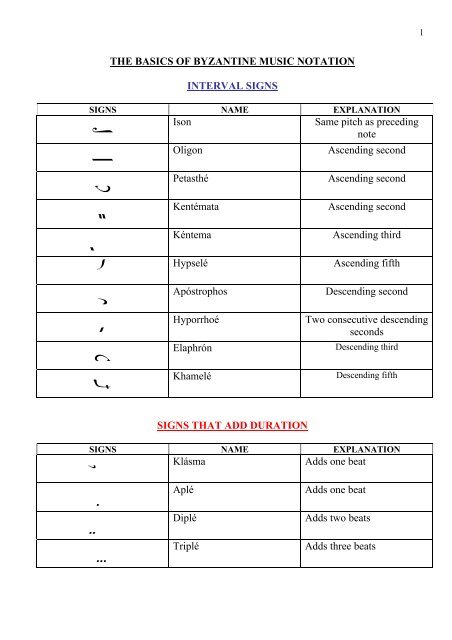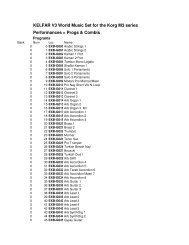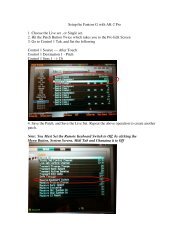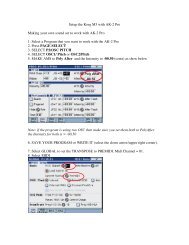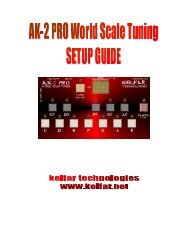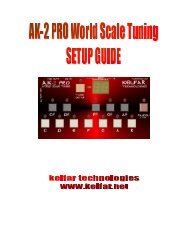The Basic of Byzantine Music Notation in English - Kelfar.net
The Basic of Byzantine Music Notation in English - Kelfar.net
The Basic of Byzantine Music Notation in English - Kelfar.net
- No tags were found...
Create successful ePaper yourself
Turn your PDF publications into a flip-book with our unique Google optimized e-Paper software.
1THE BASICS OF BYZANTINE MUSIC NOTATIONINTERVAL SIGNSqeSIGNS NAME EXPLANATIONIson Same pitch as preced<strong>in</strong>gsnoteOligon Ascend<strong>in</strong>g secondafPetasthé Ascend<strong>in</strong>g secondgKentémata Ascend<strong>in</strong>g secondKéntema Ascend<strong>in</strong>g thirdHypselé Ascend<strong>in</strong>g fifthdApóstrophos Descend<strong>in</strong>g secondHyporrhoé Two consecutive descend<strong>in</strong>ghsecondsElaphrón Descend<strong>in</strong>g thirdjkKhamelé Descend<strong>in</strong>g fifthSIGNS THAT ADD DURATION;.,MSIGNS NAME EXPLANATIONKlásma Adds one beatAplé Adds one beatDiplé Adds two beatsTriplé Adds three beats
2SIGNS THAT DIVIDE THE BEATSIGNS NAME EXPLANATION[Gorgón Divides the beat <strong>in</strong> two equalpartsyDígorgon Divides the beat <strong>in</strong> three equalpartstTrígorgon Divides the beat <strong>in</strong> four equalpartsMartyríesMartyríes show the start<strong>in</strong>g note <strong>of</strong> the melody from which we beg<strong>in</strong> to chant. <strong>The</strong>y are not<strong>in</strong>terval signs so they are not chanted. Martyríes are divided <strong>in</strong> three groups: diatonics, chromatics andenharmónicsΑ. Diatonic Martyríescnqplbvgcd.qk.MartyríesNameMartyría <strong>of</strong> NiMartyría <strong>of</strong> PaMartyría <strong>of</strong> VouMartyría <strong>of</strong> GaMartyría <strong>of</strong> DiMartyría <strong>of</strong> Ke
3lz’vn’MartyríesNameMartyría <strong>of</strong> ZoMartyría <strong>of</strong> Niapsbagsdaksz’an’sp’MartyríesΒ. Chromatic MartyríesNameMartyría <strong>of</strong> PaMartyría <strong>of</strong> VouMartyría <strong>of</strong> GaMartyría <strong>of</strong> DiMartyría <strong>of</strong> KeMartyría <strong>of</strong> ZoMartyría <strong>of</strong> NiMartyría <strong>of</strong> Paan.fpab.fgad.MartyríesNameMartyría <strong>of</strong> NiMartyría <strong>of</strong> PaMartyría <strong>of</strong> VouMartyría <strong>of</strong> GaMartyría <strong>of</strong> Di
4fkaz.’fn’MartyríesNameMartyría <strong>of</strong> KeMartyría <strong>of</strong> ZoMartyría <strong>of</strong> NiC. Enharmonic Martyríesvncpqbvgcd.qk.vz’cn.’qp’vb’MartyríesNameMartyría <strong>of</strong> NiMartyría <strong>of</strong> PaMartyría <strong>of</strong> VouMartyría <strong>of</strong> GaMartyría <strong>of</strong> DiMartyría <strong>of</strong> KeMartyría <strong>of</strong> ZoMartyría <strong>of</strong> NiMartyría <strong>of</strong> PaMartyría <strong>of</strong> VouSCALEScale, <strong>in</strong> music, declares a series <strong>of</strong> s<strong>in</strong>gle notes progress<strong>in</strong>g up or down stepwise.
5Diatonic Ni scale is consisted <strong>of</strong> the follow<strong>in</strong>g notes: Ni – Pa – Vou – Ga – Di – Ke – Zo – Ni’(Ni’ is an octave higher from Ni). Diatonic Ni scale corresponds to C Major scale <strong>in</strong> Western <strong>Music</strong>.<strong>The</strong> notes <strong>of</strong> this scale are shown <strong>in</strong> the next acrostic.Πάλαι ήµαρτεν Αδάµ, εµακρύνθη του Θεού .Βουληθείς δ΄ ο Πλαστουργός, δούλου δέχεται µορφήν,Γάλα πίνει εκ µητρός . εις µετάνοιαν καλεί,∆ιδαχών σκορπίζει φως, θαύµατα πολλά ποιεί .Κεφαλήν δ΄ εχθρού πατεί, νεκρωθείς και αναστάς,Ζωοδότης ων Θεός . και εις µέλλουσαν ζωήνΝηπενθή πιστούς καλεί, όπου πρώτος εισελθώνΠάσαν έλαβεν αρχήν παρά του Θεού Πατρός.Practice <strong>in</strong> <strong>Byzant<strong>in</strong>e</strong> <strong>Music</strong>al <strong>Notation</strong>At this part are <strong>in</strong>cluded all the necessary exercises for the practice on <strong>Byzant<strong>in</strong>e</strong> <strong>Music</strong>al <strong>Notation</strong>(parasemantic). I believe this will help all them that they would like to learn how to read <strong>Byzant<strong>in</strong>e</strong><strong>Music</strong> through the Inter<strong>net</strong>. Exercises will be grouped <strong>in</strong> chapters so to be tested the progress <strong>of</strong> the“student”. In each lesson a short theory will be preceded and then the practice.<strong>Basic</strong> rule: the read<strong>in</strong>g <strong>of</strong> <strong>Byzant<strong>in</strong>e</strong> musical notation always takes place from left to right.Chapter 1Exercises on s a dcnss\as\as\as\as\cd.ds\ds\Ni Ni Pa Pa Vou Vou Ga Ga Di Di Ga Ga Vou Vouds\ds\\cnPa Pa Ni Ni<strong>The</strong> exercise beg<strong>in</strong>s with the diatonic martyria <strong>of</strong> Ni. We cont<strong>in</strong>ue with ison, the sign thataccord<strong>in</strong>g to the table <strong>of</strong> the quantity signs has the same pitch as the preced<strong>in</strong>g note: so we repeat Ni.<strong>The</strong> exercise goes on with another ison and aga<strong>in</strong> the repetition <strong>of</strong> note Ni. Next sign is oligon, whichmeans an ascend<strong>in</strong>g second, so we read Pa until we reach martyria <strong>of</strong> Di (martyria is not chanted).After the martyria <strong>of</strong> Di, we see apόstrophes, the sign that accord<strong>in</strong>g to the table <strong>of</strong> the quantity signsmeans descend<strong>in</strong>g second, so we read Ga. At the same way we end to the martyria <strong>of</strong> Ni.
6Chapter 2cnsss\ass\ass\ass\ass\Ni Ni Ni Pa Pa Pa Vou Vou Vou Ga Ga Ga Di Di Diass\ass\ass\vn’Ke Ke Ke Zo Zo Zo Ni Ni Ni<strong>The</strong> exercise above beg<strong>in</strong>s with diatonic martyria, which corresponds to note Ni. We cont<strong>in</strong>ue ourread<strong>in</strong>g until we see ison, the sign, accord<strong>in</strong>g to the table, which conta<strong>in</strong>s the <strong>in</strong>terval signs, <strong>in</strong>dicates therepetition <strong>of</strong> the previous note. So we read Ni and we go on <strong>in</strong> the same way until the end <strong>of</strong> theexercise.Exercises on a g f dChapter 3Accord<strong>in</strong>g to the <strong>in</strong>terval signs table, Kentémata and Petasthé act the same way as oligon(Petasthé, Kentémata and oligon will be detaily expla<strong>in</strong>ed later). At this po<strong>in</strong>t, we have to mentionthat these exercises don’t follow “spell<strong>in</strong>g” rules.Exercise 1ηcnss\as\gs\gs\fs\fs\ds\dd\/////dd\cnNi Ni Pa Pa VouVou Ga Ga Di Di Ke Ke Di Di Ga VouPa NiExercise 2ηcnssss\asss\fsss\gsss\Ni Ni Ni Ni Pa Pa Pa Pa Vou Vou Vou Vou Ga Ga Ga Gagsss\fsss\asss\fsss\\vn’Di Di Di Di Ke Ke Ke Ke Zo Zo Zo Zo Ni Ni Ni Ni
7Exercise 3 ηcnsas\sfs\sas\sgs\sas\\qk.Ni Pa Pa Pa Vou Vou Vou Ga Ga Ga Di Di Di Ke KeAfter the exercise three, quantity characters wont be expla<strong>in</strong>ed any more.Άσκηση 4 ηcnsaga\assf\sddd\sfsg\sddd\Ni Ga Di Vou Disafs\vgddds\\cn


